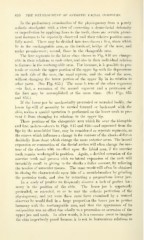Page 812 - My FlipBook
P. 812
810 THE DEVELOPMENT OF ESTHETIC FACIAL CONTOURS.
In the preliminary examination of the physiognomy from a purely
esthetic standpoint with a view of correctin<^ a dento-facial deformity
or imperfection by applying force to the teeth, there are certain promi-
nent features to be especially observed and their relative position care-
fullv noted. These may be divided into two classes : first, those which
lie in the unchangeable area, as the forehead, bridge of the nose, and
malar prominences ; second, those in the changeable area.
The four segments in the latter class shown in Fig. 846 are change-
able in their relations to each other, and also in their individual relation
to features in the unchangeable area. For instance, it is possible to pro-
trude or retrude the upper portion of the upper lip with the depressions
on each side of the nose, the nasal septum, and the end of the nose,
without changing the lower portion of the upper lip in its relation to
other parts. (See Fig. 855.) The same is true of the other segments
—in fact, a retrusion of the second segment and a protrusion of
the first may be accomplished at the same time. (See Figs. 853
and 854.)
If the lower jaw be mechanically protruded or retruded bodily, the
lower lip will of necessity be carried forward or backward with the
chin, unless a special operation is performed on the lower teeth to pre-
vent it from changing its relations to the upper lip.
Those portions of the changeable area which lie over the bicuspids
and first molars—shown in Figs. 845 and 846—and separated from the
lips by the naso-labial lines, may be considered as separate segments, as
the causes which influence a change in the contour of the cheeks diifer so
decidedly from those which change the more anterior areas. The lateral
expansion or contraction of the dental arches will often change the con-
tour of the cheeks with no effect upon the labial area, if the anterior
teeth remain unchanged in position. Again, a decided retrusion of the
anterior teeth and process with no lateral expansion of the arch will
invariably result in giving to the cheeks a fuller contour, by relieving
the tension of muscular tissues. The same result will often be obtained
in closing the characteristic open bite of a mouth-breather by grinding
the posterior teeth, and also by retracting a prognathous lower jaw.
In a study of profiles we frequently observe a lack of perfect har-
mony in the position of the chin. The lower jaw is apparently
protruded, or retruded, so as to mar the esthetic perfection of the
physiognomy, and yet were these same faces examined by a trained
observer he would find in a large proportion the lower jaw in perfect
harmony with the unchangeable area, and that the appearance of its
malposition was an effect due wholly to a protrusion or retrusion of the
upper jaw and teeth. In other words, it is a common error to imagine
the chin imperfectly posed because it is not in harmonious relations to


